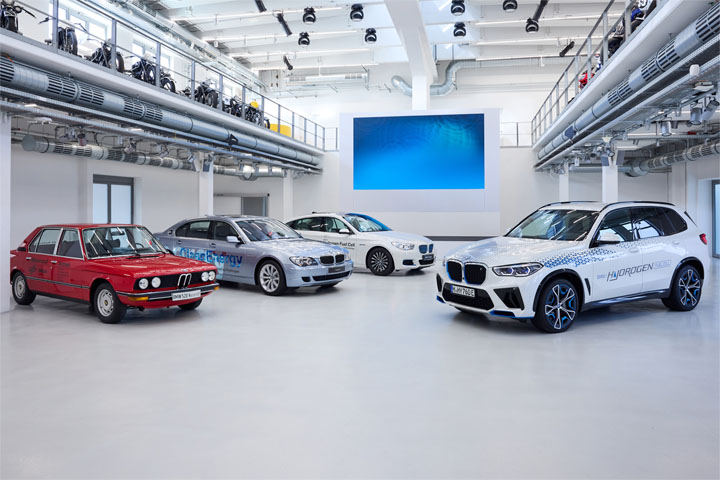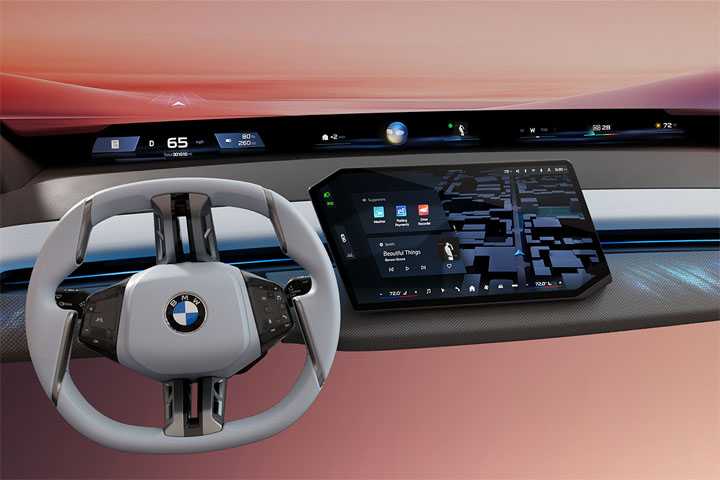+++ The first electric motor and hydrogen-powered vehicle fleet, the controversial iDrive, progressive topic clusters such as EfficientDynamics and ConnectedDrive, and NightVision – these are just a few of the many innovations generated in the FIZ +++ We present eight forward-looking ideas +++
Before we start, let’s make one thing clear: it was never the FIZ alone that came up with, realised and implemented all these ideas. It was always the work of the company as a whole.
FIZ – DIRECT COMMUNICATION AND COLLABORATION.
Let’s begin with the FIZ itself and its extraordinary architecture. In the 1980s, construction of the FIZ – known at the time as the Research and Engineering Centre – marked a new direction at BMW. For the first time in the automotive industry, the whole of product development was united under a single roof. Close proximity encouraged direct communications and collaboration, and all of the specialist departments involved were able to come together both in time and space – under a single roof. With floor space of more than 500,000 square metres, the FIZ provided office space for technical designers, logistics, purchasing and controlling, as well as engineers and IT specialists. The first section was completed and ready to go into operation as early as 1986. The building as a whole was officially inaugurated in April 1990, when the third construction phase reached completion. In 2001, it was given its current name, FIZ, for Research and Innovation Centre. Linked to the FIZ are the Aerodynamics and the Energy and Environmental Test Centres, a crash test centre and a range of engine test rigs.
ALL THAT CAME OUT OF THE BACK WAS WATER.
BMW had been experimenting with electric motors and hydrogen-powered combustion engines since the 1970s – and in 2000/2001 it was finally ready to send its fleet of specially adapted BMW 7 Series out on the Clean Energy World Tour. The vehicles concerned were intended to show the world that hydrogen works and could potentially take over from mineral oil, which is finite and environmentally damaging.
From the outset, researchers had postulated the possibility of solar hydrogen – hydrogen produced with solar energy, in other words. Just five years later, the engineers at the FIZ unveiled the first hydrogen-powered series vehicle in the world. Its elegant 12-cylinder engine emitted virtually nothing but water vapour when powered by hydrogen, but could also switch to normal combustion with standard super petrol. It was a clear signal to the whole of the automotive and energy sectors.


X5 DEFINES A NEW CLASS OF VEHICLE.
In 1999, the BMW X5 established a new vehicle segment. The all-wheel-drive Sports Activity Vehicle (SAV) featured all the sporty mod cons of a typical BMW sedan, but with wide ranging off-road capabilities. Thanks to its self-supporting body, the handling was extraordinary, both on and off the road. Along with the Range Rover, the BMW X5 was one of the first elegant off-road vehicle for city driving and became a key driver behind the popularity of these vehicles today.
THE ALL-NEW IDRIVE CONTROLLER, 2001.
Launched amid controversy, the BMW iDrive controller ended up being copied by many. The large press-and-turn button in the front section of the centre armrest was pushed, rotated and pressed, allowing drivers and front-seat passengers to operate the main entertainment, navigation, comfort, communication and vehicle settings features. Immediate visual feedback was provided in what was called the Control Display. The days of cockpit-look, with its luminous buttons and displays, were over. But not everybody liked the idea at first!
NEW-FOUND THRIFT: EFFICIENTDYNAMICS.
EfficientDynamics was born from engine developers’ considerations around the issue of sustainable mobility. The drive strategy behind it has combined maximum performance with minimum consumption since 2003. In 2007 BMW added holistic energy management to the concept, with hybrid functions and brake energy regeneration. This allowed electrical energy to be generated while decelerating and accelerating, which could then be used to power the complete on-board network. Later the Auto-Start Stop function was introduced. Life without it seems almost unimaginable.


CONNECTEDDRIVE – THE WORLD’S FIRST COCKPIT TV, 1995.
In 1994 BMW introduced the first built-in vehicle navigation system in Europe. In 1995 came a world first: the cockpit television in the BMW 750i. In 1999 BMW launched BMW Assist, bringing a crucial element of ConnectedDrive onto European roads. These first safety and service options included BMW Emergency Call, on-call service, mobility-related information services (e.g. on fuel stations, hotels etc., requested via the BMW call centre) and, of course, real-time traffic information. In 2001 BMW Online was launched, an internet-based service for specially tailored information, such as email accounts, contacts, notifications, city guides, 3D view and stock prices. Yet another world first made by BMW! ConnectedDrive finally became a thing!
ALWAYS AT THE FOREFRONT ON ACTIVE AND PASSIVE SAFETY.
Sensors, data and data analysis have always been a big deal at BMW because they allow smart functions for customers. One example is Park Distance Control (PDC), launched in 1991, which featured information on distances. A world first, the system’s ultra-sound sensors and beepers alerted parking drivers to obstacles at the front and rear of the car. Today, we can hardly imagine being without them. In 2001 BMW went one step further, adding visuals to the beepers in the new BMW 7 Series. Another innovation that was way ahead of its time is Adaptive Brake Lights, which are now an integral part of day-to-day traffic. Launched in 2002 as a world first, the two-stage LED brake lights on the rear of the car indicate how strongly the driver is braking, so the driver behind immediately knows they need to step on the brake! In 2003 the Europe-wide TeleServices was added, allowing service-relevant data to be transmitted from the car straight to the workshop to minimise the amount of time that had to be spent there.
Night Vision.
Xenon lights, launched in 1991, were already a world first from the BMW paddock – but in 2008 the team took things up a notch, with Night Vision with object recognition. Even outside the range of the headlight beam, animals and cyclists had already become easier to detect, with BMW Night Vision from 2005. But the new system added clear object recognition by highlighting potential hazards in colour. It was an innovation that made drivers feel not only more comfortable on lonely roads but also increased their sense of personal safety.





